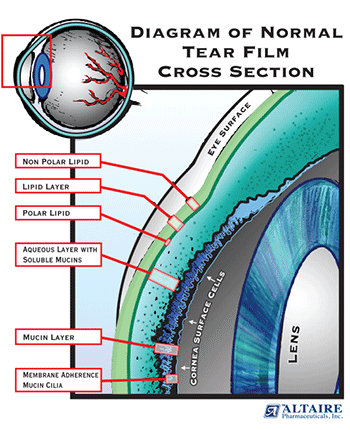
What Is Dry Eye?
Dry Eye Disease (DED) or Dry Eye Syndrome(DES) describes a common condition where excessive tear evaporation or reduced tear production results in an insufficient quantity or quality of tears necessary for healthy and comfortable eyes.
While dry eye can be caused by many factors, it is now understood that dry eye is closely associated with disorders of the eye’s tear film.

The tear film consists of three layers. A healthy tear film works to constantly produce and replenish the fresh tears required to maintain the amount of moisture needed for healthy and comfortable eyes. The largest layer is the aqueous layer. The aqueous layer is composed of the tears, which are secreted by the lacrimal glands, supplying a continuous supply of fresh tears to the eye. Along with keeping the eye moist, the tears cleanse the eye and wash away foreign particle and irritants. The mucin layer, at the bottom of the tear film, consists of proteins known as mucins produced by the conjunctival epithelium and corneal epithelia. Mucins coat the surface of the eye and allow the tears to adhere to the corneal surface of the eye. Without the mucins, the eye surface would not retain the tears it needs. The lipid layer, located at the outer layer of the tear film, consists of naturally occurring lipids produced by the Meibomian gland. These lipids cover and smooth the surface of tear film to create a continuous and uniform tear film which protects against the evaporation of the tears located at the aqueous layer. When the tear film does not function properly, the reduced quantity or quality of tears results in tear film instability.
When Dry Eye is associated with a deficiency of the lipid component of the tear film, Dry Eye is classified as evaporative dry eye disease (EDED). EDED results in a failure to form continuous and homogeneous tear film, which in turn leads to increased aqueous tear evaporation and decreased tear film stability. The most common cause of EDED is Meibomian gland dysfunction (MGD). Addressing deficiencies in lipid layer performance has been recognized as an important factor in the treatment of Dry Eye related to MGD. The ability to repair and restore the lipid layer is an important feature of any dry eye therapy related to EDED or MGD.
When Dry Eye is associated with inadequate tear production to keep the eyes comfortably lubricated, Dry Eye is classified as aqueous dry eye disease. The medical term for this is keratoconjunctivitis sicca (also known as KCS). KCS is associated with dysfunction of the aqueous tear film layer. It is commonly treated in part by the use of artificial tears to replace or add to the naturally occurring tears.
If you think you have Dry Eye disease, see your eye doctor for a diagnosis and to explore treatment options. While Dry Eye is usually not curable, the condition can often be improved with treatment.
NanoTears® is a unique innovation in Dry Eye Therapy that contains Nanopids®, tiny soothing lipids that revitalize the eye natural lubrication by restoring the lipid layer of the tear film, and providing a barrier to tear loss. The Nanopids® restore the lipid layer, and reduces tear evaporation. NanoTears®, a clear solution that gels in the eye, also lubricates and soothe the eye, providing tear replacement without the blur commonly associated with other products.
If you are a dry eye patient, ask your doctor if NanoTears® is right for you.

